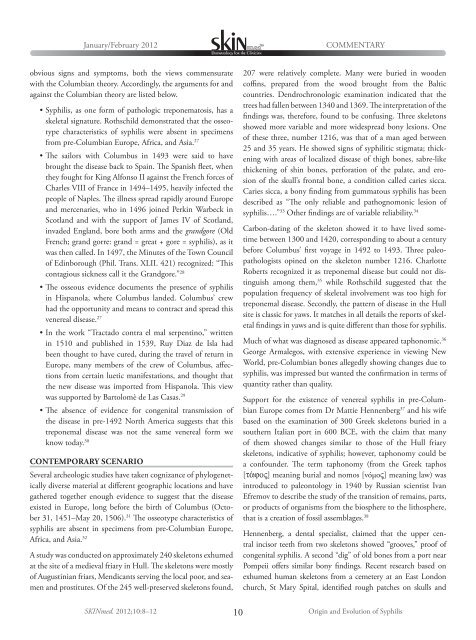January/February 2012 • Volume 10 • Issue 1 - SKINmed Journal
January/February 2012 • Volume 10 • Issue 1 - SKINmed Journal
January/February 2012 • Volume 10 • Issue 1 - SKINmed Journal
Create successful ePaper yourself
Turn your PDF publications into a flip-book with our unique Google optimized e-Paper software.
<strong>January</strong>/<strong>February</strong> <strong>2012</strong><br />
obvious signs and symptoms, both the views commensurate<br />
with the Columbian theory. Accordingly, the arguments for and<br />
against the Columbian theory are listed below.<br />
<strong>•</strong> Syphilis, as one form of pathologic treponematosis, has a<br />
skeletal signature. Rothschild demonstrated that the osseotype<br />
characteristics of syphilis were absent in specimens<br />
from pre-Columbian Europe, Africa, and Asia. 27<br />
<strong>•</strong> The sailors with Columbus in 1493 were said to have<br />
brought the disease back to Spain. The Spanish fleet, when<br />
they fought for King Alfonso II against the French forces of<br />
Charles VIII of France in 1494–1495, heavily infected the<br />
people of Naples. The illness spread rapidly around Europe<br />
and mercenaries, who in 1496 joined Perkin Warbeck in<br />
Scotland and with the support of James IV of Scotland,<br />
invaded England, bore both arms and the grandgore (Old<br />
French; grand gorre: grand = great + gore = syphilis), as it<br />
was then called. In 1497, the Minutes of the Town Council<br />
of Edinborough (Phil. Trans. XLII. 421) recognized: “This<br />
contagious sickness call it the Grandgore.” 28<br />
<strong>•</strong> The osseous evidence documents the presence of syphilis<br />
in Hispanola, where Columbus landed. Columbus’ crew<br />
had the opportunity and means to contract and spread this<br />
venereal disease. 27<br />
<strong>•</strong> In the work “Tractado contra el mal serpentino,” written<br />
in 15<strong>10</strong> and published in 1539, Ruy Diaz de Isla had<br />
been thought to have cured, during the travel of return in<br />
Europe, many members of the crew of Columbus, affections<br />
from certain luetic manifestations, and thought that<br />
the new disease was imported from Hispanola. This view<br />
was supported by Bartolomè de Las Casas. 29<br />
<strong>•</strong> The absence of evidence for congenital transmission of<br />
the disease in pre-1492 North America suggests that this<br />
treponemal disease was not the same venereal form we<br />
know today. 30<br />
CONTEMPORARY SCENARIO<br />
Several archeologic studies have taken cognizance of phylogenetically<br />
diverse material at different geographic locations and have<br />
gathered together enough evidence to suggest that the disease<br />
existed in Europe, long before the birth of Columbus (October<br />
31, 1451–May 20, 1506). 31 The osseotype characteristics of<br />
syphilis are absent in specimens from pre-Columbian Europe,<br />
Africa, and Asia. 32<br />
A study was conducted on approximately 240 skeletons exhumed<br />
at the site of a medieval friary in Hull. The skeletons were mostly<br />
of Augustinian friars, Mendicants serving the local poor, and seamen<br />
and prostitutes. Of the 245 well-preserved skeletons found,<br />
<strong>SKINmed</strong>. <strong>2012</strong>;<strong>10</strong>:8–12<br />
<strong>10</strong><br />
COMMENTARY<br />
207 were relatively complete. Many were buried in wooden<br />
coffins, prepared from the wood brought from the Baltic<br />
countries. Dendrochronologic examination indicated that the<br />
trees had fallen between 1340 and 1369. The interpretation of the<br />
findings was, therefore, found to be confusing. Three skeletons<br />
showed more variable and more widespread bony lesions. One<br />
of these three, number 1216, was that of a man aged between<br />
25 and 35 years. He showed signs of syphilitic stigmata; thickening<br />
with areas of localized disease of thigh bones, sabre-like<br />
thickening of shin bones, perforation of the palate, and erosion<br />
of the skull’s frontal bone, a condition called caries sicca.<br />
Caries sicca, a bony finding from gummatous syphilis has been<br />
described as “The only reliable and pathognomonic lesion of<br />
syphilis….” 33 Other findings are of variable reliability. 34<br />
Carbon-dating of the skeleton showed it to have lived sometime<br />
between 1300 and 1420, corresponding to about a century<br />
before Columbus’ first voyage in 1492 to 1493. Three paleopathologists<br />
opined on the skeleton number 1216. Charlotte<br />
Roberts recognized it as treponemal disease but could not distinguish<br />
among them, 35 while Rothschild suggested that the<br />
population frequency of skeletal involvement was too high for<br />
treponemal disease. Secondly, the pattern of disease in the Hull<br />
site is classic for yaws. It matches in all details the reports of skeletal<br />
findings in yaws and is quite different than those for syphilis.<br />
Much of what was diagnosed as disease appeared taphonomic. 36<br />
George Armalegos, with extensive experience in viewing New<br />
World, pre-Columbian bones allegedly showing changes due to<br />
syphilis, was impressed but wanted the confirmation in terms of<br />
quantity rather than quality.<br />
Support for the existence of venereal syphilis in pre-Columbian<br />
Europe comes from Dr Mattie Hennenberg 37 and his wife<br />
based on the examination of 300 Greek skeletons buried in a<br />
southern Italian port in 600 BCE, with the claim that many<br />
of them showed changes similar to those of the Hull friary<br />
skeletons, indicative of syphilis; however, taphonomy could be<br />
a confounder. The term taphonomy (from the Greek taphos<br />
[τα´ φος] meaning burial and nomos [vóμoς] meaning law) was<br />
introduced to paleontology in 1940 by Russian scientist Ivan<br />
Efremov to describe the study of the transition of remains, parts,<br />
or products of organisms from the biosphere to the lithosphere,<br />
that is a creation of fossil assemblages. 38<br />
Hennenberg, a dental specialist, claimed that the upper central<br />
incisor teeth from two skeletons showed “grooves,” proof of<br />
congenital syphilis. A second “dig” of old bones from a port near<br />
Pompeii offers similar bony findings. Recent research based on<br />
exhumed human skeletons from a cemetery at an East London<br />
church, St Mary Spital, identified rough patches on skulls and<br />
Origin and Evolution of Syphilis


